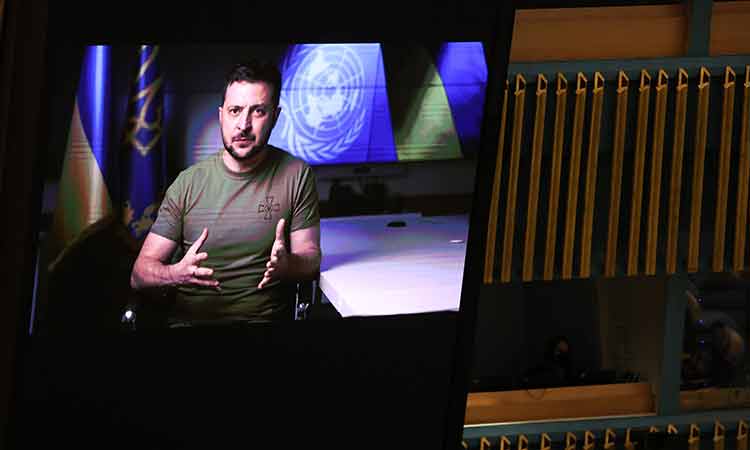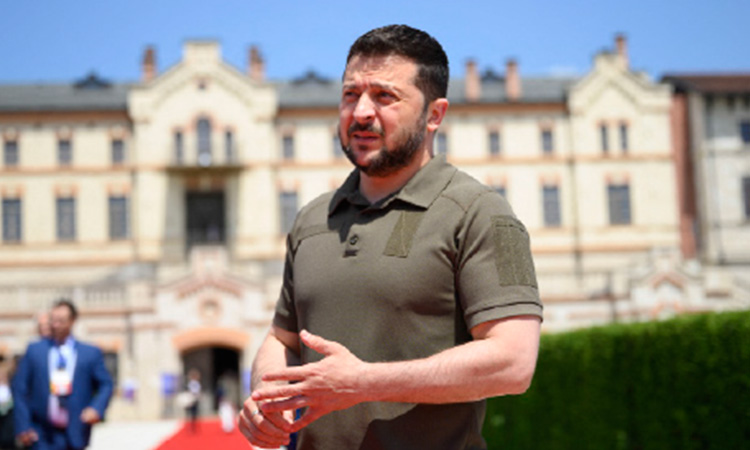When is the right time to talk about peace in Ukraine?

Volodymyr Zelensky
Daniel DePetris, Tribune News Service
The war in Ukraine has seen its fair share of twists and turns over the last 27 months. The first year was largely defined by the Russian army’s highly public missteps, from gas-less tanks stranded on the roadside to Russian soldiers redeploying to the Donbas after a failed push to take Kyiv. Then came Ukraine’s swift September 2022 counteroffensive in Kharkiv. The Ukrainians were riding high in November 2022, so much so that US intelligence agencies picked up chatter that Russian generals were talking about the use of tactical nuclear warheads. The situation, however, has deteriorated for the Ukrainians ever since.
The capture of Kherson in November 2022 was the high-water mark of Ukraine’s progress. Since then, the battlefield situation has slowly rebounded to Russia’s advantage. Moscow has regained more territory over the last two months than Ukraine did during its entire counteroffensive last year. Ukrainian President Volodymyr Zelensky is frustrated by Russia’s current operations in Kharkiv, leading Washington to loosen its ban on using US-supplied weapons to hit targets inside Russia. All of this leads to the inevitable question: At what point should Ukraine shift its strategy from total military victory toward a good-enough peace?
For many, even talking about the possibility of a diplomatic settlement with Russia is blasphemy. Russia, after all, is the aggressor, invading a sovereign neighbor and committing countless atrocities in the process. Its president, Vladimir Putin, is wanted by the International Criminal Court for war crimes. Ukraine is the victim, the logic goes, and forcing it to sit down at the same table with its victimizer leaves a sour taste in our mouths. All of that may be true to a degree. International politics, though, isn’t a morality contest — it’s at times an ugly, highly competitive slugfest between states where the ideal is rarely attainable.
To date, Zelensky has been adamant: Ukraine will only negotiate with Russia after it withdraws its troops from every inch of Ukrainian territory, including Crimea, which has been under Russian occupation for more than a decade. Zelensky’s 10-point peace plan, which demands a total Russian military withdrawal, Russian compensation for war damage and war crime prosecutions for Russian soldiers, is in effect a surrender document for Moscow. Zelensky will reiterate those same terms this month, when dozens of countries assemble in Switzerland for a so-called peace summit.
Yet that plan, although desirable, is simply not credible. In fact, given the current state of the war, as well as Putin’s willingness to sacrifice Russia’s future to maintain the roughly 20% of Ukrainian territory his forces now occupy, Zelensky’s position is downright delusional. This is one of the worst-kept secrets in international relations, one the Biden administration likely recognizes behind the scenes. The White House, of course, is highly unlikely to state this obvious fact openly. First, doing so would cause extreme strain between Washington and Kyiv at a time when both are working to hold Ukraine’s defensive lines. Second, the US would be embarrassing Zelensky by in essence calling his peace proposal a fool’s errand. And the impact on morale within the Ukrainian army could be significant — who would risk their life for a draw?
But none of these considerations outweigh the facts on and off the battlefield — and whether we like it or not, those facts now favor Russia. While Russia’s casualties are steep — the UK Ministry of Defense estimates that 465,000 Russians have been killed or wounded thus far — the Russian government is preparing for a war that could last for years. Putin is consistently throwing bodies into the fight — approximately 30,000 Russians are joining the ranks every month — and is providing lucrative bonuses and benefits to entice more young men to join. Despite stringent US and European Union sanctions, Russia has managed to redirect its crude to the east (mainly to China and India), garnering tens of billions of dollars for the treasury. The Russian economy is sustaining the war effort just as the war is sustaining the Russian economy.
Ukraine, like Russia, doesn’t have unlimited resources. But unlike Russia, it has less of pretty much everything — less fighting-aged men, less artillery shells available and less wealth to spend on a war that continues to churn with no end in sight. The Ukrainian army is stretched along a 600-mile frontline that has only gotten longer after Russia’s latest push into Kharkiv, forcing Kyiv to redirect troops that would otherwise be reinforcing the line in the Donbas.
Meanwhile, Zelensky remains hesitant to call a general mobilisation to give soldiers fighting at the front continuously for the last two years the time to rest, lest it spur political turmoil in Kyiv or further shrink the Ukrainian workforce.
None of this is to suggest that Zelensky should wave the white flag. Nothing is inevitable in war; the side that makes territorial gains this week could very well be retreating the next. The $61 billion infusion of new US aid to Ukraine is just starting to pour in, and the Ukrainians will want to see whether the latest tranche will enable them to recover lost ground. Any diplomatic settlement will also depend on Putin — if the Russian president refuses to actually compromise, then there won’t be much for Ukraine to talk about. But it’s long past time for observers of this war and US policymakers who are involved in it to drop their delusions about total military victory. Like most wars in history, this one will end through a diplomatic process with which none of the sides will be particularly enamored. The only question is how exhausted Ukraine and Russia need to become to finally negotiate seriously.







